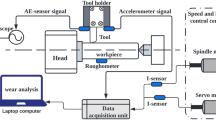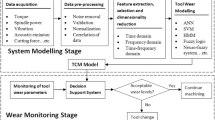Abstract
A tool condition monitoring (TCM) system is vital for the intelligent machining process. However, literature has mostly ignored the interaction effect between product quality and tool degradation and has devoted less attention to the criterion of integrated diagnostics and prognostics to cutting tools. In this paper, we aim to bridge the gap and make an attempt to propose a novel integrated tool condition monitoring system based on the relationship between product quality and tool degradation. First, a cost efficient experimentation concerning high-speed CNC milling machining was implemented. Subsequently, a comprehensive correlation investigation was performed; revealing strong positive relationship exists between product quality and tool degradation. Mapping this relationship, an integrated TCM system pertaining to diagnostics and prognostics was proposed. Herein, the diagnostic reliability was enhanced by researching on the use of a multi-level categorization of degradation. The prognostic competence was enhanced by formulating it explicitly for the tools critical zone as a function of tool life. The system is integrated in a manner that, whenever the degradation curve of the tool reaches the critical zone, prognostics module is triggered, and remaining useful life is assessed instantaneously. To enhance the performance of this system, it is modeled employing support vector machine with optimal training technique. The proposed system was validated based on the experimental data. An extensive performance investigation showed that the proposed system provides a robust problem-solving framework for the intelligent machining process.








Similar content being viewed by others
References
Al-jonid, K., Jiayang, W., & Nurudeen, M. (2013). A new fault classification model for prognosis and diagnosis in CNC machine. In Control and decision conference (CCDC), 2013 25th Chinese (pp. 3538–3543). IEEE.
Alonso, F. J., & Salgado, D. R. (2008). Analysis of the structure of vibration signals for tool wear detection. Mechanical Systems and Signal Processing, 22(3), 735–748.
Ambhore, N., Kamble, D., Chinchanikar, S., & Wayal, V. (2015). Tool condition monitoring system: A review. Materials Today Proceedings, 2(4–5), 3419–3428. doi:10.1016/j.matpr.2015.07.317.
Benkedjouh, T., Medjaher, K., Zerhouni, N., & Rechak, S. (2015). Health assessment and life prediction of cutting tools based on support vector regression. Journal of Intelligent Manufacturing, 26(2), 213–223.
Bhatt, D., Aggarwal, P., Devabhaktuni, V., & Bhattacharya, P. (2014). A novel hybrid fusion algorithm to bridge the period of GPS outages using low-cost INS. Expert Systems with Applications, 41(5), 2166–2173.
Bhuiyan, M. S. H., Choudhury, I. A., & Nukman, Y. (2012). Tool condition monitoring using acoustic emission and vibration signature in turning. In Proceedings of the world congress on engineering (vol. 3).
Castejón, M., Alegre, E., Barreiro, J., & Hernández, L. K. (2007). On-line tool wear monitoring using geometric descriptors from digital images. International Journal of Machine Tools and Manufacture, 47(12), 1847–1853.
Chang, C. C., & Lin, C. J. (2011). LIBSVM: A library for support vector machines. ACM Transactions on Intelligent Systems and Technology (TIST), 2(3), 27.
Chen, J. C., & Chen, W. L. (1999). A tool breakage detection system using an accelerometer sensor. Journal of Intelligent Manufacturing, 10(2), 187–197.
Chen, X. Q., & Li, H. Z. (2009). Development of a tool wear observer model for online tool condition monitoring and control in machining nickel-based alloys. The International Journal of Advanced Manufacturing Technology, 45(7–8), 786–800.
Cortes, C., & Vapnik, V. (1995). Support-vector networks. Machine Learning, 20(3), 273–297.
Dey, S., & Stori, J. A. (2005). A Bayesian network approach to root cause diagnosis of process variations. International Journal of Machine Tools and Manufacture, 45(1), 75–91.
Elangovan, M., Sugumaran, V., Ramachandran, K. I., & Ravikumar, S. (2011). Effect of SVM kernel functions on classification of vibration signals of a single point cutting tool. Expert Systems with Applications, 38(12), 15202–15207.
Frank, E., & Witten, I. H. (1998). Generating accurate rule sets without global optimization. In Machine learning: Proceedings of the fifteenth international conference.
Geramifard, O., Xu, J. X., Zhou, J. H., & Li, X. (2012). A physically segmented hidden Markov model approach for continuous tool condition monitoring: Diagnostics and prognostics. IEEE Transactions on Industrial Informatics, 8(4), 964–973.
Ghosh, N., Ravi, Y. B., Patra, A., Mukhopadhyay, S., Paul, S., Mohanty, A. R., et al. (2007). Estimation of tool wear during CNC milling using neural network-based sensor fusion. Mechanical Systems and Signal Processing, 21(1), 466–479.
Girardin, F., Rémond, D., & Rigal, J. F. (2010). Tool wear detection in milling—an original approach with a non-dedicated sensor. Mechanical Systems and Signal Processing, 24(6), 1907–1920.
Hsu, C. W., & Lin, C. J. (2002). A comparison of methods for multiclass support vector machines. IEEE transactions on Neural Networks, 13(2), 415–425.
Kaburlasos, V. G., Athanasiadis, I. N., & Mitkas, P. A. (2007). Fuzzy lattice reasoning (FLR) classifier and its application for ambient ozone estimation. International Journal of Approximate Reasoning, 45(1), 152–188.
Kaya, B., Oysu, C., Ertunc, H. M., & Ocak, H. (2012). A support vector machine-based online tool condition monitoring for milling using sensor fusion and a genetic algorithm. Proceedings of the Institution of Mechanical Engineers, Part B Journal of Engineering Manufacture, 226(11), 1808–1818.
Kohavi, R. (1995). A study of cross-validation and bootstrap for accuracy estimation and model selection. Proceedings of the Fourteenth International Joint Conference on Artificial Intelligence, 14(2), 1137–1145.
Kurada, S., & Bradley, C. (1997). A review of machine vision sensors for tool condition monitoring. Computers in Industry, 34(1), 55–72.
Li, X., Lim, B. S., Zhou, J. H., Huang, S., Phua, S. J., Shaw, K. C., & Er, M. J. (2009). Fuzzy neural network modelling for tool wear estimation in dry milling operation. In Annual conference of the prognostics and health management society (pp. 1–11).
Lou, M. S., Chen, J. C., & Li, C. M. (1998). Surface roughness prediction technique for CNC end-milling. Journal of Industrial Technology, 15(1), 1–6.
Malekian, M., Park, S. S., & Jun, M. B. (2009). Tool wear monitoring of micro-milling operations. Journal of Materials Processing Technology, 209(10), 4903–4914.
McCallum, A., & Nigam, K. (1998). A comparison of event models for naive bayes text classification. In AAAI-98 workshop on learning for text categorization (vol. 752, pp. 41–48).
Nakai, M. E., Aguiar, P. R., Guillardi, H., Bianchi, E. C., Spatti, D. H., & D’Addona, D. M. (2015). Evaluation of neural models applied to the estimation of tool wear in the grinding of advanced ceramics. Expert Systems with Applications, 42(20), 7026–7035.
Özel, T., & Karpat, Y. (2005). Predictive modeling of surface roughness and tool wear in hard turning using regression and neural networks. International Journal of Machine Tools and Manufacture, 45(4), 467–479.
Ren, Q., Balazinski, M., Baron, L., Jemielniak, K., Botez, R., & Achiche, S. (2014). Type-2 fuzzy tool condition monitoring system based on acoustic emission in micromilling. Information Sciences, 255, 121–134.
Rizal, M., Ghani, J. A., Nuawi, M. Z., & Haron, C. H. C. (2013). The application of I-kaz TM-based method for tool wear monitoring using cutting force signal. Procedia Engineering, 68, 461–468.
Su, J. C., Huang, C. K., & Tarng, Y. S. (2006). An automated flank wear measurement of microdrills using machine vision. Journal of Materials Processing Technology, 180(1), 328–335.
Tangjitsitcharoen, S., Thesniyom, P., & Ratanakuakangwan, S. (2014). Prediction of surface roughness in ball-end milling process by utilizing dynamic cutting force ratio. Journal of Intelligent Manufacturing, 28, 1–9.
Vallejo, A. J., Morales-Menéndez, R., Rodriguez, C. A., & Sucar, L. E. (2006). Diagnosis of a cutting tool in a machining center. In proceedings the 2006 IEEE international joint conference on neural network (pp. 3706–3713).
Wang, G. F., Yang, Y. W., Zhang, Y. C., & Xie, Q. L. (2014). Vibration sensor based tool condition monitoring using \(\nu \) support vector machine and locality preserving projection. Sensors and Actuators A Physical, 209, 24–32.
Wang, W., Wong, Y. S., & Hong, G. S. (2005). Flank wear measurement by successive image analysis. Computers in Industry, 56(8), 816–830.
Xu, Y., & Ge, M. (2004). Hidden Markov model-based process monitoring system. Journal of Intelligent Manufacturing, 15(3), 337–350.
Zhang, K. F., Yuan, H. Q., & Nie, P. (2015). A method for tool condition monitoring based on sensor fusion. Journal of Intelligent Manufacturing, 26(5), 1011–1026.
Zhong, Z. W., Zhou, J. H., & Win, Y. N. (2013, June). Correlation analysis of cutting force and acoustic emission signals for tool condition monitoring. In IEEE control conference (ASCC), 2013 9th Asian (pp. 1–6).
Acknowledgements
This research work was supported in part by the Department of Science and Technology (DST), Government of India, through Grant No. YSS/2014/000320. All the experiments were conducted at IIT Indore, India. We acknowledge the support.
Author information
Authors and Affiliations
Corresponding author
Rights and permissions
About this article
Cite this article
Jain, A.K., Lad, B.K. A novel integrated tool condition monitoring system. J Intell Manuf 30, 1423–1436 (2019). https://doi.org/10.1007/s10845-017-1334-2
Received:
Accepted:
Published:
Issue Date:
DOI: https://doi.org/10.1007/s10845-017-1334-2




